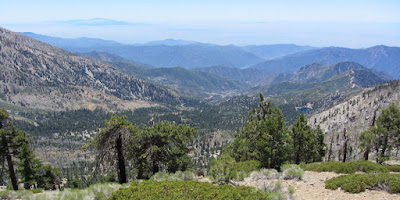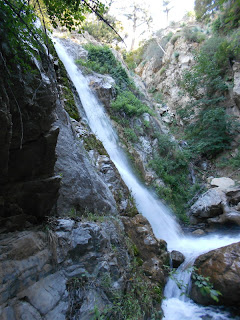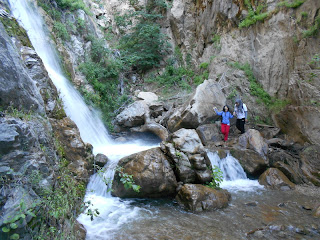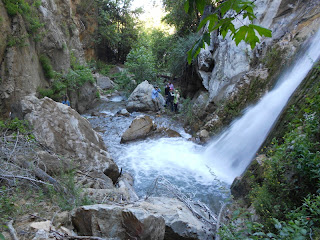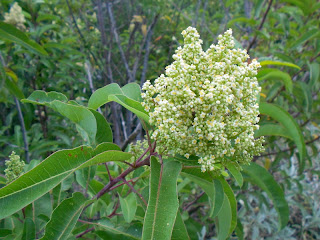 See Rincon Red Box Road to Summit 2908' Hike Description at Dan's Hiking Pages
See Rincon Red Box Road to Summit 2908' Hike Description at Dan's Hiking Pages
I awoke at 4:40 AM on Sunday. Time to go hiking. Am I a diehard? I went hiking the last three Saturdays, so I knew that I needed to spend this Saturday on household chores, and it was a productive day. When I went to bed I told myself that if I woke up by 4:30 I’d go on a hike. And 4:40 was close enough. It would be a scrappy hike since I needed to be home by 9:30 before church. I coined the term “scrappy hike”--a hike which I generally define as being close to home, one which I have hiked numerous times, and one which I fit on a scrap of carved out time. A scrappy hike is just a way to get me outdoors and to get in or stay in condition for a primetime hike.
 Rincon Road (2N24) seemed to be the ideal scrappy hike for this morning. The trailhead is about 20 minutes from my home in Azusa up Hwy 39. I drove by the trailhead last Saturday en route to and from Crystal Lake and noticed that a Station Fire closure sign was still up, even though it is well out of the current Station Fire closure area as shown on the current FS map. I called the FS this week and they confirmed it is indeed open--at least for hiking and bicycling.
Rincon Road (2N24) seemed to be the ideal scrappy hike for this morning. The trailhead is about 20 minutes from my home in Azusa up Hwy 39. I drove by the trailhead last Saturday en route to and from Crystal Lake and noticed that a Station Fire closure sign was still up, even though it is well out of the current Station Fire closure area as shown on the current FS map. I called the FS this week and they confirmed it is indeed open--at least for hiking and bicycling.
 5:50 AM - Begin hike. The car thermometer reads 67 degrees. The sky is cloudy. My pace is fast since the major purpose for the hike is to put 7 miles on my legs and be back to the car by 9:10. The flora story of the morning is California buckwheat--lot of the creamy white flowers in bloom.
5:50 AM - Begin hike. The car thermometer reads 67 degrees. The sky is cloudy. My pace is fast since the major purpose for the hike is to put 7 miles on my legs and be back to the car by 9:10. The flora story of the morning is California buckwheat--lot of the creamy white flowers in bloom.
I’m generally not a fire road kind of guy when it comes to hiking, but sometimes you just have to hike on what’s available, particularly for a scrappy hike. On nice thing about a fire road is that you can walk at a fast pace and still be able to look around and enjoy the scenery without worrying about stepping off the trail and tumbling down the mountain. Another nice thing about fire roads is that the surface often makes a nice canvas to capture tracks. This morning I see various tracks including deer (with a fawn), large animal (maybe mountain lion), small animal (maybe raccoon), snake, human (in shoes), bikes, and motor vehicles.
 I love the beauty of the morning. Quall flutter through the brush. A rabbit sitting in the middle of the road watches me for a long time as I approach before he hops away. I am surrounded by mature chaparral, thick and richly textured. Only a few occurrences of Spanish broom are still in bloom with their beautiful and fragrant yellow flowers--now most of the plants are covered with bean pods. I snap pics along the way but have to be deliberate in keeping an earnest pace since the clock is ticking. I see my destination far up the canyon. The road climbs steeply. I’m working up a sweat. The varied clouds make a picturesque sky and create a purplish din on the high country to the north and east.
I love the beauty of the morning. Quall flutter through the brush. A rabbit sitting in the middle of the road watches me for a long time as I approach before he hops away. I am surrounded by mature chaparral, thick and richly textured. Only a few occurrences of Spanish broom are still in bloom with their beautiful and fragrant yellow flowers--now most of the plants are covered with bean pods. I snap pics along the way but have to be deliberate in keeping an earnest pace since the clock is ticking. I see my destination far up the canyon. The road climbs steeply. I’m working up a sweat. The varied clouds make a picturesque sky and create a purplish din on the high country to the north and east.
6:38 - Hairpin turn passing over the main canyon watercourse a couple minutes past Fern Springs. Heading northeast now along the east wall of the canyon. Pass the 2-mile marker at 6:43.
 6:55 - Hairpin turn at 2.5-mile point. Splendid views. Linger long enough to get pics in all directions. I wonder about the prominent peak due east. It would offer superb views into San Gabriel Canyon but would require serious bushwhacking through steep terrain to get there. As I continue it begins to lightly sprinkle. I resist digging out my poncho. Pass 3-mile marker at 7:11. Still sprinkling.
6:55 - Hairpin turn at 2.5-mile point. Splendid views. Linger long enough to get pics in all directions. I wonder about the prominent peak due east. It would offer superb views into San Gabriel Canyon but would require serious bushwhacking through steep terrain to get there. As I continue it begins to lightly sprinkle. I resist digging out my poncho. Pass 3-mile marker at 7:11. Still sprinkling.
7:19 - Arrive at the canyon head and the off-trail junction to the ridge and Summit 2908, my destination. The route is considerably more overgrown than when I was last here in April 2007, so I decide to continue up the road on ground I’ve not covered before. Not sprinkling any more. Up ahead I spot a water tank on a spur ridge and figure that it would be a good turn-around point.

canyon head and Summit 2908
7:32 - Arrive at Madrone water tank. The slightly concaved top of the cement tank catches rain water to be stored for use in fighting fires. I’d love to continue north another half mile to an outward bend that would certainly yield some striking views, but a scrappy hike does not yield much time for exploring. I calculate I’m at an elevation of about 2,860 feet, so a gain of 1,300 feet in 3.5 miles has been a descent workout. Start back at 7:44. I have about an hour and 25 minutes to cover 3.5 miles. It’s doable. My pace is steady.
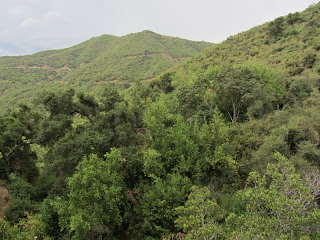 8:02 - 3-mile marker. Soon the sun pokes through the clouds a little. Pass the 2.5-mile turnout point at 8:13 and the 2-mile marker at 8:23. Better lighting now for pics. Pass 1-mile marker at 8:44 (actually it’s just a surveyor stick right now; elev. 2,039; I don’t know if they will replace it with a permanent marker). I’m on pace for being back on time. Pass a couple bikers heading up the road; one guy has a machete.
8:02 - 3-mile marker. Soon the sun pokes through the clouds a little. Pass the 2.5-mile turnout point at 8:13 and the 2-mile marker at 8:23. Better lighting now for pics. Pass 1-mile marker at 8:44 (actually it’s just a surveyor stick right now; elev. 2,039; I don’t know if they will replace it with a permanent marker). I’m on pace for being back on time. Pass a couple bikers heading up the road; one guy has a machete.
9:05 - Done with time to spare. No other vehicles at the trailhead, so I wonder where the bicyclists came from. Thermometers says 73 degrees. Still cloudy with some sprinkles on my car.
Epilog - What an enjoyable scrappy hike! The freshness of early morning. Pleasant weather. Clouds that restrained their precipitation. Beautiful scenery. Good workout. And nearly 7 miles of total solitude in the busiest National Forest in the country.
See Rincon Red Box Road to Summit 2908' Hike Description at Dan's Hiking Pages






